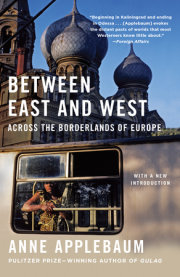i
The Greed That Binds
In the summer of 1967, Austrian and West German capitalists from the gas and steel industries met a group of Soviet communists in the quiet confines of an old Habsburg hunting lodge near Vienna. The atmosphere must have been strange. Soviet troops had left Austria only twelve years earlier. West German soldiers still stared down East German soldiers across a fortified border in Berlin. Fears of imminent Soviet invasion had faded, but only thanks to the large American military presence in Europe.
Nevertheless, everyone in the room had interests in common. Soviet engineers had just discovered huge gas fields in western Siberia. New technology meant that gas was becoming cleaner, cheaper, and easier to transport. Pipelines from the communist East to the capitalist West seemed an excellent way for both sides to benefit. The group talked and agreed to meet again. The conversation then continued in other cities, moving from the price of gas to the cost of loans to the technology of pipeline construction. In February 1970, West German and Soviet officials finally concluded the agreement that would lead to the construction of the first gas pipelines from the U.S.S.R. to Western Europe.
Prior to that deal, economic exchange between Western Europe or the United States and the Soviet Union had been minimal, involving nothing much more complex than trade in icons, timber, and grain, plus a few dodgy mining deals. From the moment the hunting lodge talks began in Austria, everyone knew that the gas trade would be different. Pipelines were expensive and permanent. They could not be laid down one day, removed the next, and they could not depend upon the whim of a particular leader. There had to be long-term contracts, and these contracts had to be enveloped within a set of predictable political relationships.
For Willy Brandt, the West German foreign minister at the time, these predictable relationships were a large part of the project’s appeal. He did not fear that his country would become dependent on the Soviet Union. On the contrary, he leaned on his negotiators, urging them to make the deal bigger. His reasoning was mostly political: he believed that a mutually dependent economic relationship would make a future military conflict unthinkable. As chancellor, which he eventually became, Brandt made his Ostpolitik—his “eastern policy”—one of the central pillars of postwar German foreign policy. In subsequent years, the pipelines provided a physical link between Moscow and Bonn, and eventually Berlin, Rome, Amsterdam, Helsinki, and dozens of other European cities. They remained at the center of German foreign policy after 1991, when the Soviet Union broke up and Germany reunited.
Along the way, Germany’s Ostpolitik also became a theory of change, explaining not merely how democracies could trade with autocracies but how they could slowly and subtly alter them. Egon Bahr, a longtime adviser to Brandt, described the idea in a famous speech in 1963, calling this concept Wandel durch Annäherung (change through rapprochement). If the West could tone down the confrontation, engage with the East German regime, and offer trade instead of boycotts, he argued, then a “loosening of the borders” might be possible. Bahr never called for boycotts or sanctions against the East Germans and rarely mentioned political prisoners, even though he knew the political prisoners were there: West Germany frequently paid for the release of dissidents from East German prisons, spending more than 3 billion deutsche marks on this strange human trade in the years before 1989. Instead of speaking clearly about prisoners or human rights, Bahr deployed what the writer Timothy Garton Ash has called “emotive imprecision” to evade the subject.
Not everyone else was so certain about the pipeline deals. Richard Nixon always believed that the Soviet Union’s true purpose in trading and talking with Brandt and Bahr was, as Nixon put it, “to detach Germany from NATO.” Jimmy Carter, who wanted to prioritize the promotion of human rights over trade, disliked Ostpolitik so much that he imposed a boycott on the sale of some U.S. pipeline technology to Germany after the Soviet Union imprisoned two dissidents, Aleksandr Ginzburg and Natan Sharansky, in 1978. Helmut Schmidt, German chancellor at the time, fumed that Carter was an “idealistic preacher” who knew nothing about Russia. The Reagan administration took a step further, placing export controls on some pipeline equipment following the declaration of martial law in Poland in 1981, blocking American companies from working on the pipeline, and banning foreign companies involved in the project from doing business in the United States, all radical moves at the time.
Nixon, Carter, and Reagan were motivated by neither spite nor pure commercial self-interest, but rather by questions about the political consequences of trade with an autocracy. Although Germany was the prime contractor, the gas benefited many countries, potentially making the entire continent dependent on Soviet goodwill. Could the pipelines be used as blackmail? Reagan’s defense secretary, Caspar Weinberger, worried out loud about the need to limit “Soviet economic leverage over the West.”
Underlying this conversation lay a deeper moral and political question: Did East–West trade enrich and empower the Soviet state and its empire? From the time of the Bolshevik Revolution, the Kremlin’s foreign policy goals had explicitly included the subversion of European democracies. During the 1970s and 1980s, the U.S.S.R. supported terrorist groups in West Germany and Italy, aided extremist movements across the Continent and around the world, and suppressed political opposition in Eastern Europe, including East Germany. Nevertheless, gas kept flowing west and hard currency flowed east, providing Moscow with funding that helped sustain the same Red Army that NATO had to be prepared to fight and the same KGB that Western security services competed against. If this trade empowered Moscow, was it really beneficial? What were the hidden costs? While the Soviet Union existed, this paradox of U.S. and European policy was never really resolved, and it remained unresolved after the U.S.S.R. broke apart.
In the 1990s, an era when most people expected to enjoy the new peace dividend and spend the rest of the time talking about television shows, the hidden costs of anything were hardly mentioned at all. This was the era of Francis Fukuyama’s “End of History?,” the 1989 National Interest essay that was widely misread as a statement of naive, everything-is-for-the-best-in-the-best-of-all-possible-worlds good cheer. Liberal democracy is victorious, sooner or later everyone will want it, and no special effort is required to promote it; just be patient, and the beneficial effects of trade and globalization will work their magic. Fukuyama’s actual argument was more subtle than that, but the simplified version became popular because people wanted it to be true.
And no wonder: The idea that there was something preordained, even inevitable, about liberal democracy had a deep appeal. It made the inhabitants of democracies feel virtuous, since they already lived in the ideal society. It made the businessmen and bankers who were just then beginning to expand their investments into China and the post-Soviet world feel better too. If the old moral dilemmas about investing in autocracy were gone, then there was nothing special they needed to do to justify their actions.
It was around this time that Bahr’s old phrase Wandel durch Annäherung, “change through rapprochement,” morphed into Wandel durch Handel—“change through trade.” This pleasing rhyme not only sounded better in German; it also reflected reality. Trade among the postwar democracies in Western Europe, in the form of the increasingly integrated common market, really had produced peace and prosperity. After 1990, many hoped trade would also enrich the eastern half of the Continent and bring it closer, politically and culturally, to the western half. Wandel durch Handel became popular partly because it suited the world of commerce but also because it described the actual experience of ordinary people.
So much confidence was placed in the efficacy of trade that some quickly forgot the harder-edged policies that also contributed to European reunification. In 2014, Berlin marked the twenty-fifth anniversary of the fall of the Berlin Wall, and I attended the formal celebrations, led by the German chancellor, Angela Merkel. Mikhail Gorbachev was in the room, as a kind of victory token, as was Lech Wałęsa. But President George H. W. Bush, who had actually negotiated the end of the Soviet Union and the breakup of the Soviet Empire, was scarcely mentioned. Nor did the American troops who helped deter Soviet attack for so many decades, and who were (and still are) based in Germany, get much attention. Violence, soldiers, armies, and above all nuclear weapons had been written out of the story.
The Germans believed that trade and diplomacy had reunited their country. They also believed that trade and diplomacy would, eventually, help normalize relations between Russia and Europe. At the same time, and for similar reasons, many Americans and Europeans came to believe that trade would also bring harmony to the Pacific, by integrating China into the democratic world. They too had grounds for hope: different factions were jockeying for power in China, including some that wanted liberal reforms. As the scholar Julian Gewirtz has recently written, Chinese economists in this era maintained a surprisingly wide array of contacts with Western economists, borrowing their analysis of markets and trade as well as their understanding of the links between economic growth and political culture. A more liberal China, if not exactly a democratic China, seemed well within reach, including to many Chinese.
Nevertheless, it is remarkable, in retrospect, how quickly so many Western analysts and leaders from across the political spectrum leaped upon the most optimistic of all possible scenarios. As early as 1984, just a few years into Deng Xiaoping’s reforms, Ronald Reagan visited China and declared, in a sunny, optimistic, upbeat speech, that “there’s much to be gained on both sides from expanded opportunities in trade and commerce and cultural relations.” He was sure he had seen signs of a deeper change: “The first injection of free market spirit has already enlivened the Chinese economy. I believe it has also made a contribution to human happiness in China and opened the way to a more just society.”
Copyright © 2024 by Anne Applebaum. All rights reserved. No part of this excerpt may be reproduced or reprinted without permission in writing from the publisher.













